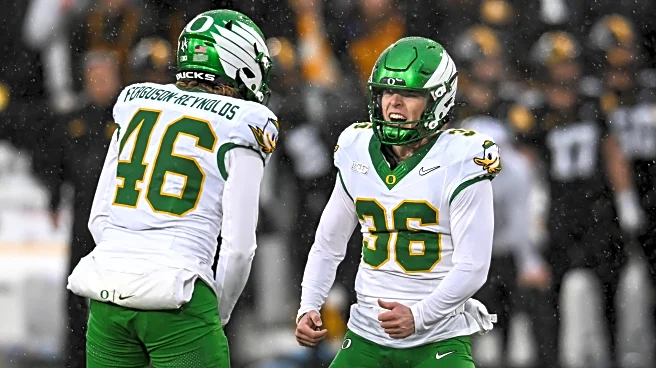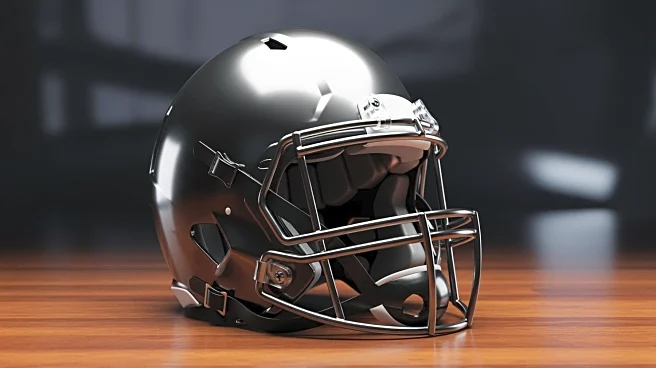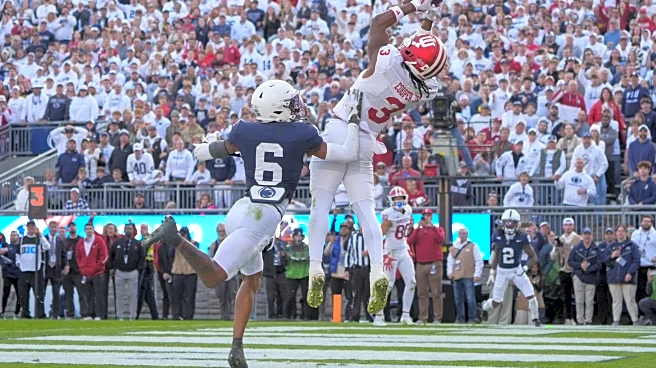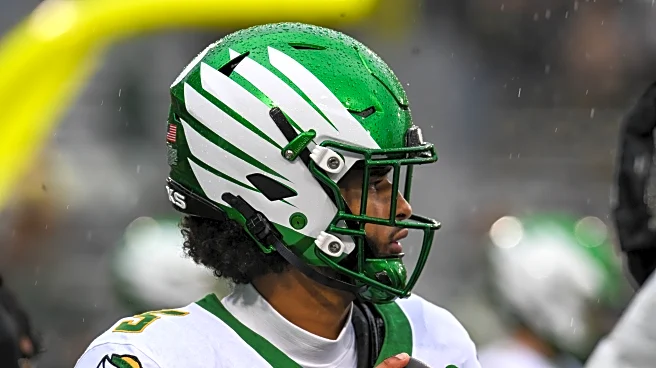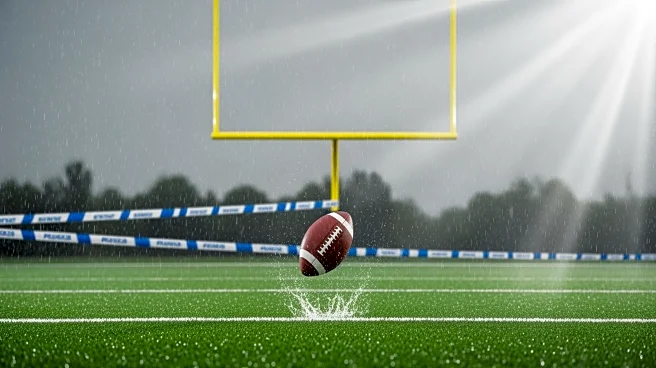In previewing Iowa hythloday noted there were two likely scenarios for how Saturday’s game would play out. The scenario most favorable to Oregon was to hit several explosive plays early and win going away
as the Hawkeyes struggled to throw the ball for multiple sustained scoring drives overcome a large deficit. The scenario favoring Iowa was a low scoring game early that would allow their ball control offense to limit possessions and produce a high variance end game of the kind they are very proficient at navigating. As it transpired, the game actually favored Iowa in most ways.
Although the game went into the high variance scenario, the Ducks had the edge on special teams. Place kicker #36 Atticus Sappington confirmed Ecoop’s analysis of him as a highly reliable college kicker from less than 50 yards going 3 for 3 in harsh weather. Less noticeably, but perhaps just as importantly, Sappington on kickoffs and punter #46 Ferguson-Reynolds never allowed dangerous return man Iowa #21 Wetjen a chance for a big play. This allowed Oregon to tie the game despite giving up explosive plays due to lack of discipline in the Ducks’ pass coverage in the 4th quarter. The difference ended up being the 2 points the Ducks got from a bad snap that went over the head of the Hawkeye’s punter into the end zone.
Offense
Oregon had nine offensive possessions in this game, six of which were full field drives that all finished inside Iowa’s 30 yard line. Coming away from this with only one touchdown and three field goals is disappointing, but seemed to be in line with the strategy Oregon adopted by the end of the second quarter: they could escape Kinnick with 3 pointers. When running the season long numbers I will likely call both end of half drives from this game garbage time as the play calling is not representative of the entire season. After consulting with hythloday, however, I have included all the plays it took to get into field goal range on these drives in this week’s numbers as that appeared to represent the strategy for this game in particular.
The offensive strategy used by teams that have had the most past success against Iowa can be quickly summarized as: throw to get 6-9 yards on 1st down, take a deep shot on 2nd down, then run in 3rd and short to move the chains if needed. With bad weather and numerous injuries to the receivers (especially after WR #2 Bryant was hurt in the first quarter), Oregon soon started to lean heavily on their run game. The team’s effectiveness on the ground exceeded anything I would have expected going in, and I approve of OC Will Stein’s decision to lean into the run on 1st down once it was clear they could get chunk yards against Iowa’s defense.
With the benefit of hindsight, I do think there were opportunities to have avoided an under two-minute drive ending in a walk off field goal, and instead put the game away much earlier. Oregon found the yards needed on 1st down to exploit the Hawkeye defense, just on the ground rather than through the air. There were seven instances of “money downs” with a great chance to take a deep shot (2nd and 4 or less, or 3rd and 4 or less when field position would have made a 4th down attempt reasonable) with field position such that the QB could put the air under the ball and ensure the DBs who always play from behind had no chance of an interception, and even if they missed the offense could simply run on the subsequent short-yardage down to pick up the conversion. The no-risk / high-upside proposition of a shot in these scenarios means failing to throw and just running for the conversion right away leaves money on the table.
But on all seven of these occasions against Iowa, no deep pass option was part of the play call. Three of these were in the second half when Oregon still had the lead, so it could be argued running the clock was more important than trying to score. The four instances in the first half have no such possible justification. The extended possessions this decision necessitated resulted in only a single touchdown as key errors in Iowa territory (the interception, QB #5 Dante Moore getting stepped on by his own lineman, and a dropped pass) halted drives.
The question that occurs, and I do not have a definitive answer, is why did Stein not send WR #4 Benson deep in such situations? There are two possibilities that come to mind. The first is that the Ducks offensive staff wanted to take the shots but got scared. Specifically the combination of injured receivers, bad weather, and QB #5 Dante Moore’s early interception convinced them it was too risky and they just kept the ball on the ground. This is probably the best case scenario as the game winning drive can build confidence among the players in themselves and among the staff in their own players for the future. The other possibility is that the staff never wanted to seek out explosive plays and were confident they could beat Kirk Ferentz at his own game. In this case they were lucky to get away with it and it would be worrisome to anticipate a repeat of this strategy.
For all the praise I heaped on RB #0 Davison for helping jump start the offense last week, veteran RB #6 Whittington was also highly effective and he led the way this week. All of Oregon’s backs routinely were able to improvise and run through contact. Even with OT #78 Wilson starting in place of RT #71 Harkey, the line had one of its best run blocking games so far this year with a total 17.14% error rate. Below is a representative sample of successful rushing plays.
(Reminder – You can use the controls in the bottom right of the embedded player to alter the playback speed and/or enter full screen mode.)
- :00 – With TE #18 Sadiq ruled out right before the game, TE #83 Saleapaga saw frequent use in 12-personnel with TE #9 Ja. Johnson. The alignment of both receivers to the field has pulled the SAM linebacker out of the box so the seventh defender on the LoS to the offense’s right is a DB. Leading the way on counter #75 Pregnon takes out the DE and the corner is no match for Johnson. Whittington is left one-on-one with the safety and runs through a tackle.
- :17 – We also saw reserve TE #44 Grace, usually the FB out of the I-formation, as a blocker in other situations. Here he is off set in the pistol to Moore’s left. Multiple running backs means Iowa has three linebackers on the field. With #23 Hill lined up as a receiver to the boundary there are only six defenders in the box, however. Grace and C #72 Laloulu get just enough of the linebackers for Davison to get 5 yards on first down.
- :32 – Iowa had successfully stuffed a first down run for only a yard prior to this play. The offense tries to catch the defense off guard by handing to Hill on a sweep. The WILL actually plays it well, so WR #14 Lowe has to leave the corner unblocked. It was the right decision as Hill is able to bend down and run through tackles for a big gain.
- :47 – The defense is playing the run very aggressively late in the game and it nearly pays off. The WILL attacks downhill on a run blitz and Ja. Johnson barely gets a piece of him. It’s enough for the quick feet of Davison though, as he sidesteps the penetration in the backfield and dodges the safety to take advantage of the second level blocks by Laloulu and Pregnon.
The Hawkeyes had been underwater defending rushing efficiency all season, but the Ducks broke through their “four yard force field” and also achieved explosive runs. When they could string together a couple successfully defended plays in a row, failures in the passing game allowed Iowa to halt most of Oregon’s drives short of the end zone. Here’s a sample of unsuccessful rushing plays.
- :00 – This play in the first quarter shows some of the difficulties RT #78 Wilson had making his first start of the season. Davison is trying to lead Hill around the right side of the offense where the defensive alignment has left them vulnerable to being outflanked. Wilson gets beaten inside by starting DE Iowa #48 Llewellyn and Hill has to cut downfield to avoid losing yardage.
- :14 – The Ducks try to run outside zone to the offense’s right, into the boundary, but penetration never lets Davison get going. Pregnon lunges out of his stance and completely misses the linebacker while LT #76 World is risking a holding call trying to slow down the backside DE. When RG #74 Iuli can’t release from the double team quickly enough to get to the MIKE Davison has to muscle forward for a yard.
- :22 – Ja. Johnson and Wilson are supposed to double team the DE on the offense’s right before one of them releases to the linebacker. Unfortunately they both release to second level defenders but initial contact means neither reaches their targets in time to make contact. Whittington gets around the DE but runs into a crowd of Hawkeyes immediately afterward.
- :29 – Grace is in the backfield again and it appears Davison is supposed to follow him through the A-gap between Laloulu and Pregnon as the linebackers overrun the play. Iuli’s defender beats him playside and causes a pile up as Wilson has let his man go to catch the runner from behind.
There were few enough passing attempts I couldn’t get a good sample for a separate analysis. While there were some explosive plays, most completions went for 5 yards or fewer. Some examples:
- :00 – This was a rare instance of an extra rusher being sent by Iowa, but it is picked up well as Hill chips the SAM so Iuli can get into position in slide protection. The play action fake sucks up the linebackers and the field safety leaving room from Ja. Johnson to run right by them on a corner route.
- :17 – With the clock running in a two minute drill this flare out to Whittington is meant to pick up about five yards and get out of bounds to stop the clock before 3rd and short. The ball is delivered quickly but behind the receiver. Whittington makes a terrific catch for four yards to stay ahead of the chains, but has to fall down in bounds so the clock keeps running.
- :28 – Another two minute situation, this time with the game on the line. Oregon has all three time outs and are only trying to get to about the 25 for a field goal attempt. Moore plays it safe and takes what is immediately available to true freshman #17 Perry over the middle.
- :35 – Later in the same drive, down to two time outs with about 34 yards to go (CBS’ field goal range line is extremely generous). Once Moore sees the corner bailing deep he knows he has an easy first down on the stop route to WR #11 McClellan. Iowa #8 Lee does a good job to recover and cut off the receiver from the sideline so his teammate can make the tackle in bounds to keep the clock moving.
Pass protection was actually very good in this game, though curiously Iowa rarely brought pressure even on third downs. Their plan, so effective against typical Big Ten quarterbacks, of swarming the short and intermediate areas with defenders in zone was effective when Oregon wasn’t trying to take the top off the defense. There was no single cause for most failures: QB, receivers, and protection all shared the blame. Here is a sample of failed passing plays.
- :00 – In third and long the offense is keeping the back and TE in protection, anticipating a blitz. The linebackers bail in a simulated pressure at the snap, leaving only three receivers in the pattern. Moore is trying to look off the boundary safety to open up a slant to WR #4 Benson, but he doesn’t see the nickel sitting underneath the route in zone coverage and nearly throws an interception.
- :24 – The telestrator anticipates where the safety is going in coverage, but that isn’t the problem. There are three separate execution failures by the offense on this third and long. Against a simulated pressure there are no defenders with good leverage against the slant run by Ja. Johnson but he loses his balance when bumped by the safety. Moore doesn’t have time to look the safety off and make that throw even if the TE had stayed upright as World misplays the E/T stunt so there is pressure in his face. The ball has to come out, but once the field corner turns his hips inside the safest option is to throw to Lowe’s outside shoulder down the sideline where it’s an incompletion at worst. The quarterback tries to thread the needle inside to Perry and the corner is able to run the route for the receiver, so the offense doesn’t even get a chance at a field goal.
- :45 – I like the design of this interior screen for the TE who begins split out wide, but it is most effective against an opponent who is likely to blitz. Iowa DC Parker is known to do this on third and long, but by late in the second quarter he had already shown that on this day he preferred to play coverage. Iuli and Laloulu have to take the linebackers, Iuli gets just enough contact to keep Ja. Johnson upright but Laloulu whiffs. Even then, with seven defenders in pass coverage the safety is unblocked and takes a good angle on the ball carrier.
- 1:00 – Third and long on a drive in the 4th quarter that could ice the game with a touchdown. Moore rolls to his right to buy time and delivers an accurate throw to a well run out past the sticks, but the ball is dropped.
Defense
I had stated my curiosity whether DC Tosh Lupoi and his staff would alter their personnel usage facing run oriented offenses in November. The answer was a definitive yes. Rather than bringing in OLB #9 Purchase in a 3–4 package against 12 or 21 personnel, Oregon routinely brought in an extra defensive tackle. We also saw a deeper rotation of players on the interior defensive line, with DE #29 Porter and DT #77 Jer. Johnson seeing meaningful playing time.
While the Ducks struggled against Iowa’s run game with efficiency, which was foreseeable, this rotation did an excellent job preventing long gains. There was only a single explosive run the entire game, coming at the very end of the fourth quarter with the defense trying to regroup after a 4th down conversion. Of Iowa’s eight drives, only three made it into the red zone. The rest petered out, though a 58 yard field goal did net vital points.
The surprising development was that the three times Iowa reached the red zone was due to explosive passing plays. One of these was a nearly miraculous sideline catch by heinously underused Iowa WR #2 Philips that got a questionable illegal hands to face penalty added to it. Aside from this, in the first half there were a couple creative play calls that confused the Duck’s secondary in coverage. On their final scoring drive, Iowa didn’t do anything particularly unusual but there were key coverage breakdowns that nearly cost Oregon the game.
In addition to the rotation along the line, an injury to LB #26 Jackson meant the starting duo of LB #28 Boettcher and LB #54 Mixon had to play almost every snap. The few times they did leave the field we did get glimpses of redshirt freshman #20 Willams and #23 Platt. Below are examples of successful rush defense.
- :00 – The Hawkeyes are in 11-personnel, but in a tight formation so LB #28 Boettcher (the offense’s right) and nickel #22 Canady (on their left) are on the line of scrimmage. Lined up at nose tackle #1 Alexander discards the RG and gets immediate penetration as Boettcher pursues down the line after inducing the QB to hand off.
- :06 – There is a late shift from the defense here. They had been showing a 1-high safety look but rotate into their two high look with S #31 Thieneman only ten yards deep as a “strong safety.” The Hawkeyes run counter to the offenses right where DE #10 Uiagalelei blows up the play by wrong arming the center, pushing him back first into the pulling guard and then the runner. The guard was supposed to block LB #54 Mixon, who is now free, and the delay buys time for CB #4 Finney to arrive as well.
- :15 – Iowa routinely had QB #11 Gronowski spin opposite the direction of the play before pitching the ball on these outside zone runs from under center. If this is meant to deceive the defense where the play is going the Ducks never bought it. On the play side OLB #44 Tuioti keeps his right arm free to set the edge while DT #52 Washington splits a double team. Despite losing his feet Washington creates a pile up so the back has to redirect to where CB #5 Th. Johnson takes his legs out from under him.
- :23 – Iowa is behind schedule in 2nd and 9, so they need more than a four yard gain but that is all the defense allows. Washington plays textbook 2-gap technique, controlling the offensive lineman with his arms so he can clog one gap then discard his blocker and move to the other. Tuioti, playing from depth rather than on the line, doesn’t over commit and reacts quickly when the back declares his path.
Though chunk gains were hard to come by, the Hawkeyes routinely got enough push on the ground to move the chains. I did see more 1-high safety sets, and even when two safeties were playing deep they were often only ten yards from the line of scrimmage. Iowa still made progress even against these extra bodies. Here is a sample of unsuccessful rush defense.
- :00 – Iowa has two tight ends on the field, so reserve DT #50 Gray is the 7th defender in the box and lined up at nose tackle. He gets high out of his stance and is pushed back by the double team at the snap. Boettcher is untouched but dips his head too soon and overruns the back, who pushes forward for a first down.
- :20 – The Hawkeyes frequently had WR #21 Wetjen go in motion across the formation to threaten a sweep, but it was usually a fake as it is here. Aside from that this is a textbook outside zone run. Another reserve DT, this time #99 Green, plays with poor pad level and gets moved aside. On the edge DE #29 Porter gets his shoulders turned perpendicular to the LoS by the RT and TE. Thieneman has to come down to fill the gap and makes an excellent tackle with perfect form in the hole. By then the back can twist in his grasp for a first down.
- :35 – The Ducks are fully expecting a run on first down with the Hawkeyes under center in 12-personnel and in tight formation. Thieneman is the only deep safety so counting Finney there are 9 defenders in the box against 8 blockers. To the offense’s right, there is no push even with the pulling blockers in this gap scheme, so Iowa’s back #28 Moulton has to improvise. Gray (playing 3-tech on the offense’s left) gets moved by another double team. Finney is in man coverage against Iowa #15 Vander Zee so gets pulled out of position as the receiver executes a Big Ten block against S #21 Flowers. Fortunately Uiagalelei gets a hand on the runner as he cuts back against the play, otherwise this would have been an explosive run.
- :55 – The only defender with leverage to defend the sweep to Wetjen coming across the formation of the offense’s right to left is Uiagalelei. He plays his assignment by keeping outside contain. I’m not sure the sweep was live since Gronowski never puts the ball in the receiver’s belly, but the snap was timed so that the defense couldn’t see that before having to commit. Gronowski has to go right up the middle and Washington gets a hand on him but Boettcher is pulled out of position by the sweep motion and walled off by the right tackle. The quarterback is strong enough to muscle through Finney and Flowers for the first down.
Though their occasional successes were very successful, most of the time Iowa had the same struggles they had displayed all season. Gronowski struggled with accuracy, especially under pressure, and receivers couldn’t gain separation from defenders. Below is a sample of successful pass defense.
- :00 – Iowa is about as comfortable in third-and-long passing situations as the three service academies. Oregon runs a simulated pressure as Tuioti rushes from the middle of the field while Boettcher bails into coverage at the snap. Gronowski has plenty of time against a four man rush, but there are seven defenders in coverage against three receivers and nobody breaks open. After leaving the pocket he simply has to throw the ball away.
- :21 – Another third down and at first it looks like a blitz from Oregon. Iowa is setting up a screen pass designed to attack the void where Boettcher is rushing from. However it is actually only a four man rush, as OLB #9 Purchase and LB #54 Mixon peel off into coverage. From his short zone Mixon reads the QB’s eyes and steps into the lane Gronowski needs to get the ball to Wetjen. If thrown the ball is probably intercepted. The quarterback does well to keep his grip as he has to tuck the ball away before Boettcher levels him.
- :40 – The Hawkeyes try to take the defense by surprise with play action out of the I-formation on first down. Notice that against two tight ends Oregon is using an extra lineman and Boettcher is in the “strong safety” position in front of Thieneman and Flowers. Both offensive tackles do a little dance rather than gaining depth or simulating a run block and Gronowski soon has Uiagalelei in his face. He shows impressive strength to stay upright and check the ball down. Finney forces the back out of bounds with reserve LB #23 Platt ready to help if needed.
- 1:07 – In third and medium, seven defenders crowd the short area of the field. Boettcher stays short as a “robber” with Flowers deep and the rest follow their assignments in man coverage (notice CB #7 Obidegwu get away with a bump in traffic as the Iowa receivers try to rub him and Canady with a mesh). Pressure from Uiagalelei forces Gronowski to break right where nobody is open as Washington closes in. A receiver breaks away deep on the scramble drill but no QB is making that throw under duress.
The most frustrating aspect of the few failures in pass defense is that nearly all of them were preventable with better execution from the defense. Some plays were more difficult to defend than others due to play design, but I suspect all of the clips I have included led to some “choice words” in the meeting rooms on Sunday and Monday. Examples of failed pass defense are shown below.
- :00 – The orbit motion from Wetjen and half roll right from Gronowski are meant to get the defense flowing that direction, and it works perfectly. Specifically Thieneman gets sucked up even though after all the backfield motion only Wetjen and the tight end are eligible receivers to the field, with the TE in pass protection. He should stay deep to guard against deep routes breaking to the field. Possibly because he sees Thieneman out of position, Flowers stays with the X-receiver lined up to the offense’s left running a post. This leaves no one deep to help Boettcher against the flanker when he goes vertical. The Hawkeyes scored a touchdown with a well designed screen on the next play.
- :29 – I wouldn’t normally use a split screen clip, but I didn’t have many choices for this game. Iowa is in an unbalanced formation with three receivers to the field, so it is vital Tuioti keeps inside leverage when he drops into coverage. He loses position, so a completion is probably inevitable. It could be kept to a short gain by Finney if he drove on the TE rather than looking downfield and getting distracted.
- :47 – The running back stays in pass protection so Boettcher “green dogs” and goes for the QB but there is no immediate pressure on third down. This drive could probably still have been stopped cold if not for a complete coverage bust by the deep safeties. On the high angle you can see Flowers drifting to his left despite there being no receiver there aside from the one Finney has locked up on the sideline. The quarterback is looking directly down the middle of the field so he should be staying there and gaining depth. Thieneman watches the tight end cross his face and turns to his right, despite Canady and Mixon having the short area bracketed and that deep third being Th. Johnson’s responsibility. He is driving on an in-breaking route after Gronowski has already started his windup looking nowhere near that receiver. The tight end simply runs by both of them.
- 1:21 – There are three defenders over three receivers to the offense’s right as Iowa has to convert fourth down to keep their hopes alive. I cannot tell if Thieneman is supposed to drive on the in breaking route while Finney bails deep, or if Canady is supposed to guard the middle while Thieneman stays deep. I do know there shouldn’t be two defenders guarding the flat, especially when Tuioti and Boettcher are both rushing the passer.
